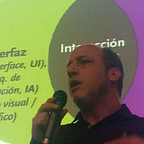UX+AI: 2024 won’t be like 1984. Well, on second thought…
In 1984, Apple introduced Macintosh, the computer that changed the graphic design industry and processes. The TV commercial proclaimed that 1984 “won’t be like 1984” (Orwell’s dystopian novel).
Today, with artificial intelligence, history repeats itself for UX. It will be like 1984… but which one? The answer is: Yes.
The impact of the Mac on graphic design processes
At first, it was obvious that the introduction of the computer to Graphic Design would impact technical fields such as typesetting (and the jobs associated with it).
Almost without us realizing it, another less predictable impact manifested in a short time, not on the final deliverables, but on the process itself: the elimination of the sketching phase with the client. Instead of iterating ideas with the client, we jumped to present them “almost final” proposals. This way, we managed to satisfy their insatiable anxiety at the cost of losing their engagement with the process.
At first, the clients seemed happier: fascinated by the higher level of representation, they congratulated us and gave us their approval. But then they went back to their old ways: I don’t think so, I don’t feel it, my brother-in-law told me. And we no longer had the sketching phase to clear situations.
In the end, the process ended up taking more or less the same time as before, but instead of working like tailors taking the client’s measurements, we went on to show them one proposal after another so that they could tell us which one they liked… as if they were buying underwear.
If history serves as a guide, my prediction is that AI, applied to UX, will also eliminate the low-fidelity prototyping… and the instances of exploration and inquiry needed to innovate.
An ideal use of AI in UX would be to produce rapid prototypes to test with users, taking great care that the higher fidelity that is free to obtain, does not generate biases nor attachment from stakeholders in the initial instances of the project.
But the truth is that many colleagues no longer test. They consider that battle against client anxiety already lost. The next logical step will be to use AI to produce the deliverables that anxious clients demand more quickly.
In other words, to take for granted the vulgar idea that “design” would be the mere execution of the client’s ideas. Ideas that are… design decisions. Decisions that the client made without adequate tools, and without even knowing that he was making decisions.
If we are among the increasingly unlucky ones who every day feel like “mouse drivers”, cheer up! If we do nothing, today will be better than tomorrow, when we will be mere prompt monkeys.
AI is not the right answer to client anxiety. Because anxiety has no bottom.
When we add a technology N to a human problem X, caused by a human defect (such as anxiety), the result is not a solution. It is problem X to the Nth power.
To remedy this, the solution is not “AI” or “No AI”. It is to accept our historical role: we are the ones who must earn the professional respect we need to do our job, and build by example the foundation for our practice and that of those who succeed us.
If you think we need and deserve it, follow me! (in other words, like & subscribe).
